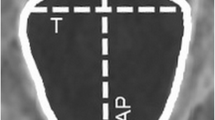Abstract
Background
Though the craniovertebral junction is often abnormal in children with Crouzon’s syndrome, no study had measured accurately the size of their foramen magnum (FM).
Patients and methods
We compared the FM size (area, diameters) on computed tomography examination in 21 children with a genetically confirmed Crouzon’s syndrome prior to any surgery and in 23 control children without craniofacial abnormalities. We extrapolated the growth pattern in both groups.
Results
We found a statistically significant smaller FM area (p = 0.0228), FM sagittal diameter (p = 0.0287), and FM sagittal posterior diameter (p = 0.0023) in children with Crouzon’s syndrome. No differences were detected with regard to the transversal diameter. Hydrocephalus in children with Crouzon’s syndrome was associated with a small FM area (p = 0.05), small sagittal diameter (p = 0.023), small sagittal posterior diameter (p = 0.0173), and reduced transversal diameter (p = 0.03985). No association of the aforementioned findings was found with the position of the cerebellar tonsils or the lambdoid suture functional state (open or fused). Comparable results were observed among the two genetic forms (exon 8 or 10 mutations). Concerning the growth pattern, a first phase of rapid increase and a second phase of slow increase could be recognized in all the measurements in both populations, though with some significant differences.
Discussion and conclusions
The growth of FM follows a biphasic pattern in both Crouzon’s and control children. The sagittal diameter and the global size of the FM are mostly affected in children with Crouzon’s syndrome. The small FM, especially its posterior part, is likely to play a key role in the physiopathology of hydrocephalus.












Similar content being viewed by others
References
Bliesener JA, Schmidt LR (1980) Normal and pathological growth of the foramen occipitale magnum shown in the plain radiography. Pediatr Radiol 10(2):65–69
Carinci F, Pezzetti F, Locci P, Becchetti E, Carls F, Avantaggiato A, Becchetti A, Carinci P, Baroni T, Bodo M (2005) Apert and Crouzon syndromes: clinical findings, genes and extracellular matrix. J Craniofac Surg 16(3):361–368
Cinalli G, Chumas P, Arnaud E, Sainte-Rose C, Renier D (1998) Occipital remodeling and suboccipital decompression in severe craniosynostosis associated with tonsillar herniation. Neurosurgery 42(1):66–71, discussion 71–73
Cinalli G, Renier D, Sebag G, Sainte-Rose C, Arnaud E, Pierre-Kahn A (1995) Chronic tonsillar herniation in Crouzon’s and Apert’s syndromes: the role of premature synostosis of the lambdoid suture. J Neurosurg 83(4):575–582
Cinalli G, Sainte-Rose C, Kollar EM, Zerah M, Brunelle F, Chumas P, Arnaud E, Marchac D, Pierre-Kahn A, Renier D (1998) Hydrocephalus and craniosynostosis. J Neurosurg 88(2):209–214
Cinalli G, Spennato P, Sainte-Rose C, Arnaud E, Aliberti F, Brunelle F, Cianciulli E, Renier D (2005) Chiari malformation in craniosynostosis. Childs Nerv Syst 21(10):889–901
Cleveland WS (1979) Robust locally weighted regression and smoothing scatterplots. J Am Stat Assoc 74(368):829–836
Cleveland WS, Devlin SJ (1988) Locally weighted regression: an approach to regression analysis by local fitting. J Am Stat Assoc 83(403):596–610
Collmann H, Sörensen N, Krauss J (2005) Hydrocephalus in craniosynostosis: a review. Childs Nerv Syst 21(10):902–912
Couly GF, Coltey PM, Le Douarin NM (1993) The triple origin of skull in higher vertebrates: a study in quail–chick chimeras. Development 117(2):409
Crouzon O (1912) Dysostose cranio-faciale héréditaire. Bull Mem Soc Med Hop Paris 33:545–555
Di Rocco F, Jucá CE, Arnaud E, Renier D, Sainte-Rose C (2010) The role of endoscopic third ventriculostomy in the treatment of hydrocephalus associated with faciocraniosynostosis. J Neurosurg Pediatr 6(1):17–22
Francis PM, Beals S, Rekate HL, Pittman HW, Manwaring K, Reiff J (1992) Chronic tonsillar herniation and Crouzon’s syndrome. Pediatr Neurosurg 18(4):202–206
Goodrich JT (2005) Skull base growth in craniosynostosis. Childs Nerv Syst 21(10):871–879
Helms JA, Amasha RR, Leucht P (2007) Bone voyage: an expedition into the molecular and cellular parameters affecting bone graft fate. Bone 41(4):479–485
Huang R, Zhi Q, Patel K, Wilting J, Christ B (2000) Contribution of single somites to the skeleton and muscles of the occipital and cervical regions in avian embryos. Anat Embryol 202(5):375–383
Kruyff E, Jeffs R (1966) Skull abnormalities associated with the Arnold Chiari malformation. Acta Radiol Diagn (Stockh) 5:9–24
Milhorat TH, Nishikawa M, Kula RW, Dlugacz YD (2010) Mechanisms of cerebellar tonsil herniation in patients with Chiari malformations as guide to clinical management. Acta Neurochir (Wien) 152(7):1117–1127
Nishikawa M, Sakamoto H, Hakuba A, Nakanishi N, Inoue Y (1997) Pathogenesis of Chiari malformation: a morphometric study of the posterior cranial fossa. J Neurosurg 86(1):40–47
Noetzel MJ, Marsh JL, Palkes H, Gado M (1985) Hydrocephalus and mental retardation in craniosynostosis. J Pediatr 107(6):885–892
Proudman TW, Clark BE, Moore MH, Abbott AH, David DJ (1995) Central nervous system imaging in Crouzon’s syndrome. J Craniofac Surg 6(5):401–405
Richards GD, Jabbour RS (2011) Foramen magnum ontogeny in Homo sapiens: a functional matrix perspective. Anat Rec (Hoboken) 294(2):199–216
Sainte-Rose C, LaCombe J, Pierre-Kahn A, Renier D, Hirsch JF (1984) Intracranial venous sinus hypertension: cause or consequence of hydrocephalus in infants? J Neurosurg 60(4):727–736
Sgouros S, Natarajan K, Hockley AD, Goldin JH, Wake M (1999) Skull base growth in childhood. Pediatr Neurosurg 31(5):259–268
Stovner LJ, Bergan U, Nilsen G, Sjaastad O (1993) Posterior cranial fossa dimensions in the Chiari I malformation: relation to pathogenesis and clinical presentation. Neuroradiology 35(2):113–118
Thompson DN, Harkness W, Jones BM, Hayward RD (1997) Aetiology of herniation of the hindbrain in craniosynostosis. An investigation incorporating intracranial pressure monitoring and magnetic resonance imaging. Pediatr Neurosurg 26(6):288–295
Tubbs RS, Shoja MM, Ardalan MR, Shokouhi G, Loukas M (2008) Hindbrain herniation: a review of embryological theories. Ital J Anat Embryol 113(1):37–46
Author information
Authors and Affiliations
Corresponding author
Rights and permissions
About this article
Cite this article
Coll, G., Arnaud, E., Selek, L. et al. The growth of the foramen magnum in Crouzon syndrome. Childs Nerv Syst 28, 1525–1535 (2012). https://doi.org/10.1007/s00381-012-1805-x
Received:
Accepted:
Published:
Issue Date:
DOI: https://doi.org/10.1007/s00381-012-1805-x




